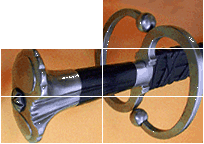E.B. Erickson Landsknecht Sword
Original: Mid-16th century Germany

The term
Landsknecht translates to mean "servant of the country" and seems to have originated in Germany around 1470-80 when a troop of soldiers was commissioned for the service of Charles the Bold of Burgundy. Only a few short decades later, Maximilian I, who married the daughter of Charles and inherited the Burgundian legacy, was forced to defend his inheritance and so raised a force said to be the first
Landsknecht army on German lands. This army engaged in combat across the Continent, particularly during the Italian Wars of 1494-1559.
The
Landsknechte were equipped with a variety of weapons that included the pike, halberd, and
zweihänder (two-handed) sword. Alongside these primary weapons, a smaller secondary one was often carried such as a short sword called a
katzbalger. This name basically translates to "cat-skinner" or "brawler" and is thought to refer to combat seen in the close-quarters situations in which it would be used.
The
katzbalger is characterized by having a recurved figure-eight guard and seems to have come into use sometime in the beginning of the 16th century. By the middle of that century, some variants started to inherit added guards to aid in hand protection, a feature common for many sword designs during that period. This trend for more and more complex
katzbalger hilt forms may have formed a prototype for later-period examples of fully developed Continental basket-hilted swords.
The sword featured here exhibits details found on many extant examples including a katzbalger from The Historisches Museum, Dresden (FD 197-020) and two others from
The Royal Armouries, Leeds (IX.898 and IX.169). It features detailed file-work throughout and includes writhen motifs of roped and twisted shapes to create a complex and beautiful piece.
The quillons are looped round in a figure-of-eight pattern and attach to a knuckle-bow that extends upwards towards the pommel. An additional loop attaches to the center of the outside quillon and connects again to the knuckle-bow.
A single side ring sits within the outside quillon. The back of the hilt has an additional bar looped to form a finger-ring. Itís worthwhile to note that the presence of the side ring actually prevents a finger from passing over the cross-guard and through the quillons. One might then assume that the figure-ring is superfluous but it is suggested that its presence is not to provide protection for a curled-over finger but instead is there to provide support on the back of the hilt to as a means of protecting the thumb.
The pommel is an ovoid mushroom shape encompassed by a roped band and has deeply fluted patterns radiating from its center. The grip is a wood-cored spiraled shape, wrapped with alternating bands of twisted and straight wires and is finished with fine Turk's head knots. The scabbard is of double-leather construction and has an incised decorative motif of geometric lines combined with an ornate chape that includes the same roped band and twisted knob as found on the hilt.
The blade is from
Del Tin Armi Antiche of Italy and was highly modified by E.B. Erickson. Take note of the spatulated tip that is so characteristic of these types of swords. One wider central fuller extends three-quarters the length of the blade and is flanked by two shorter ones. A small ricasso can be seen at the base near the hilt.
Overall length: 36.625"
Weight: 2.6 pounds
Width of guard: 4"
Blade: 31" long; 1.75" wide tapering to 1.25"
Fullers: 1 @ 23.5" long; 2 @ 11" long
Grip and pommel: 5.125" long
Point of Balance (PoB): 2.5" from guard
Center of Percussion (CoP): ~21" from guard
Maker:
E.B. Erickson.

Based on several surviving examples including this one from the Dresden Historisches Museum.


